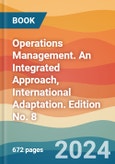Operations Management: An Integrated Approach, 8th edition, provides a solid foundation of the subject with clear, guided instructions and a balance between quantitative and qualitative concepts, thus providing both an applied and practical approach. In addition to leveraging customizable, tactile teaching and learning methods, the text covers emerging topics like artificial intelligence, robotics, data analytics, and sustainability.
This international edition includes several revisions and additions to the content, including updated company examples across all chapters, updated discussions with regard to the latest technologies that impact operations and supply chain management, and revised problems in all chapters. In addition, the edition includes a new “Pandemic Effects” box that addresses how the chapter topic has evolved or changed during the COVID-19 pandemic and how it is evolving in a post-pandemic environment.
Table of Contents
1 Introduction to Operations Management
Chapter Overview
What Is Operations Management?
Differences Between Manufacturing and Service Organizations
Operations Management Decisions
Historical Development
Today’s OM Environment
Operations Management in Practice
Within OM: How It All Fits Together
2 Operations Strategy and Competitiveness
Chapter Overview
The Role of Operations Strategy
Developing a Business Strategy
Developing an Operations Strategy
Strategic Role of Technology
Productivity
Operations Strategy Within OM: How It All Fits Together
3 Product Design and Process Selection
Chapter Overview
Product Design
The Product Design Process
Factors Impacting Product Design
Process Selection
Designing Processes
Process Performance Metrics
Linking Product Design and Process Selection
Technology Decisions
Designing Services
Product Design and Process Selection Within OM: How It All Fits Together
4 Supply Chain Management
Chapter Overview
Basic Supply Chains
Issues Affecting Supply Chain Management
The Role of Purchasing
Sourcing Decisions
The Role of Warehouses
Implementing Supply Chain Management
Supply Chain Management Within OM: How It All Fits Together
5 Total Quality Management
Chapter Overview
Defining Quality
Cost of Quality
The Evolution of Total Quality Management (TQM)
The Philosophy of TQM
Quality Awards and Standards
Why TQM Efforts Fail
Total Quality Management (TQM) Within OM: How It All Fits Together
6 Statistical Quality Control
Chapter Overview
What Is Statistical Quality Control?
Sources of Variation: Common and Assignable Causes
Descriptive Statistics
Statistical Process Control Methods
Control Charts for Variables
Control Charts for Attributes
Process Capability
Six Sigma Quality
Acceptance Sampling
Implications for Managers
Statistical Quality Control in Services
Statistical Quality Control (SQC) Within OM: How It All Fits Together
7 Just-in-Time and Lean Systems
Chapter Overview
The Philosophy of JIT
Elements of JIT
Just-in-Time Manufacturing
Total Quality Management
Respect for People
Benefits of JIT
Implementing JIT
JIT in Services
JIT and Lean Systems Within OM: How It All Fits Together
8 Forecasting
Chapter Overview
Principles of Forecasting
Steps in the Forecasting Process
Types of Forecasting Methods
Time Series Models
Causal Models
Measuring Forecast Accuracy
Selecting the Right Forecasting Model
Collaborative Planning, Forecasting, and Replenishment (CPFR)
Forecasting Within OM: How It All Fits Together
9 Capacity Planning and Facility Location
Chapter Overview
Capacity Planning
Making Capacity Planning Decisions
Decision Trees
Location Analysis
Making Location Decisions
Capacity Planning and Facility Location Within OM: How It All Fits Together
10 Facility Layout
Chapter Overview
What Is Layout Planning?
Types of Layouts
Designing Process Layouts
Special Cases of Process Layout
Designing Product Layouts
Group Technology (Cell) Layouts
Facility Layout Within OM: How It All Fits Together
11 Work System Design
Chapter Overview
Work System Design
Job Design
Work Measurement
Compensation
Work System Design within OM: How It All Fits Together
12 Inventory Management
Chapter Overview
Basic Inventory Principles
Inventory Management Objectives
Relevant Inventory Costs
ABC Inventory Classification
Inventory Record Accuracy
Determining Order Quantities
Determining Safety Stock Levels
The Periodic Review System
Inventory Management within OM: How It All Fits Together
13 Aggregate Planning
Chapter Overview
Business Planning
Aggregate Planning Options
Aggregate Plan Strategies
Developing the Aggregate Plan
Aggregate Planning within OM: How It All Fits Together
14 Resource Planning
Chapter Overview
Enterprise Resource Planning
The Benefits and Costs of ERP
Material Planning Systems
How MRP Works
Capacity Requirements Planning (CRP)
Resource Planning Within OM: How It All Fits Together
15 Scheduling
Chapter Overview
Basic Scheduling Concepts
Developing a Schedule of Operations
Optimized Production Technology
Scheduling Issues for Service Organizations
Scheduling Within OM: Putting It All Together
16 Project Management
Chapter Overview
The Project Life Cycle
Project Management Concepts
Estimating the Probability of Completion Dates
Reducing Project Completion Time
The Critical Chain Approach
Project Management Within OM: How It All Fits Together








